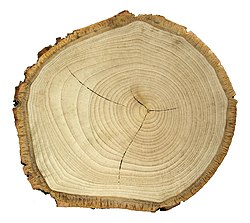Dendrochronology
Dendrochronology is tree-ring dating. It is a method of dating which uses the patterns of growth rings in trees. In many types of wood, the time rings were formed can be dated to the exact calendar year.
Dendrochronology has three main uses:
- radiocarbon dating, where it is used to calibrate radiocarbon ages.[1]
- archaeology, where it is used to date old buildings, etc.
- palaeoecology, where it is used to determine certain aspects of past climates
In some parts of the world, it is possible to date wood back a few thousand years, or even many thousands. The maximum for "fully anchored chronologies" is a little over 11,000 years from present.[2] The term "fully anchored chronology" means the dates are absolutely certain.
History
Dendrochronology (word derived from Greek δένδρον, dendron, "tree limb"; χρόνος, khronos, "time"; and -λογία, -logia) was developed during the first half of the 20th century originally by the astronomer A.E. Douglass, who founded the Laboratory of Tree-Ring Research at the University of Arizona. Douglass researched sunspot activity. He expected changes in solar activity would affect climate patterns on Earth. The climate would be recorded by tree-ring growth patterns.
The phenomenon of tree rings and their relationship with wet and dry years had been noticed before Douglass. There is a brief note in one of Leonardo da Vinci's notebooks, and Charles Babbage in 1837 came up with the same idea.[3]
How it works
Many trees in temperate zones make one growth ring each year, with the newest adjacent to the bark. Through a tree's life, a year-by-year ring pattern is formed which reflects the climatic conditions in which the tree grew. Adequate moisture and a long growing season result in a wide ring. A drought year may result in a very narrow one.
Alternating poor and favorable conditions, such as mid summer droughts, can result in several rings forming in a given year. Problems like this are fixed by comparing one part of the world with another. Missing rings are rare in oak and elm trees: the only recorded instance of a missing ring in oak trees occurred in the year 1816, also known as the Year without a Summer.[4]
Trees from the same region will tend to develop the same patterns of ring widths for a given period. These patterns can be compared and matched ring for ring with trees growing in the same geographical zone and under similar climatic conditions. Following these tree-ring patterns from living trees back through time, chronologies can be built up, both for entire regions, and for sub-regions of the world. Thus wood from ancient structures can be matched to known chronologies (a technique called cross-dating) and the age of the wood determined precisely.
The tree-ring dates can be extended back to 26,000 BP[5] by using other methods. Those other methods use marine sediment layers and growth rings in corals.[6][7]
Dendrochronology Media
A "tree cookie" cross-section of a Coast Douglas-fir tree displayed in the Royal Ontario Museum. The tree was over 500 years old when it was cut down in British Columbia in the 1890s. The markings indicating historical events were added in the 1920s.
Diagram of secondary growth in a tree showing idealised vertical and horizontal sections. A new layer of wood is added in each growing season, thickening the stem, existing branches and roots, to form a growth ring.
Silver lime cross section showing annual rings.
References
- ↑ This is needed because the concentration of carbon-14 in the atmosphere varies with time and place. The relatively short-lived 14C is renewed by cosmic ray bombardment on atmospheric nitrogen. The bombardment is slightly variable.
- ↑ McGovern P.J.; et al. (1995). "Dendrochronology". Science in archaeology: a review. AJA. Vol. 99. pp. 79–142. doi:10.2307/506880. JSTOR 506880. S2CID 193071801.
- ↑ Watson, Peter 2009. Ideas: a history, from Wittgenstein to the word wide web. London: Folio Society, p294. Original edition was titled A terrible beauty: the people & ideas that shaped the modern world. London: Weidenfeld & Nicolson, 2000.
- ↑ Lori Martinez (1996). "Useful tree species for tree-ring dating". Retrieved 2008-11-08.
- ↑ BP = Before Present, where "present" is 1 January 1950.
- ↑ Reimer, Paula J.; et al. (2004). "INTCAL04 Terrestrial radiocarbon age calibration, 0–26 cal kyr BP" (PDF). Radiocarbon. 46 (3): 1029–58. doi:10.1017/S0033822200032999. S2CID 38359692.
- ↑ Fairbanks, Richard. "Current research: radiocarbon calibration". Columbia. Archived from the original on 2011-08-25. Retrieved 2012-09-24.







